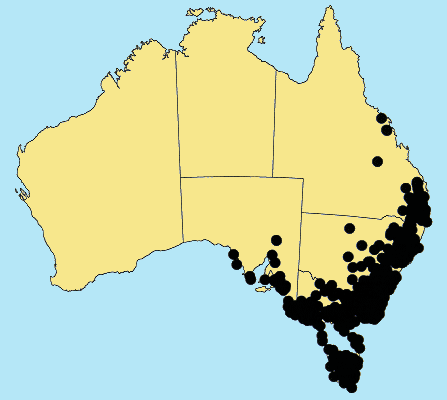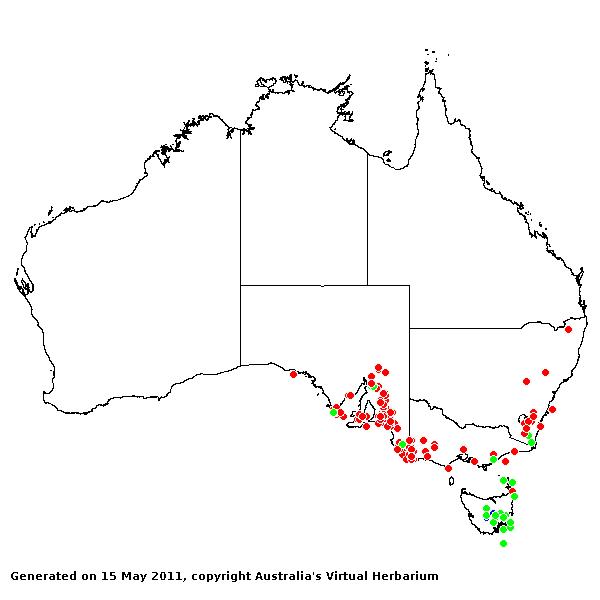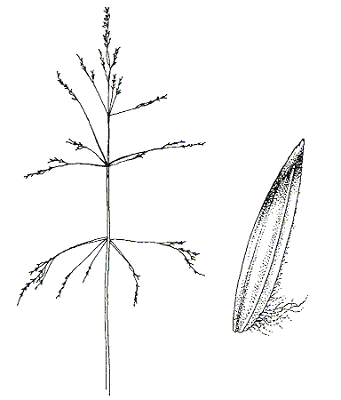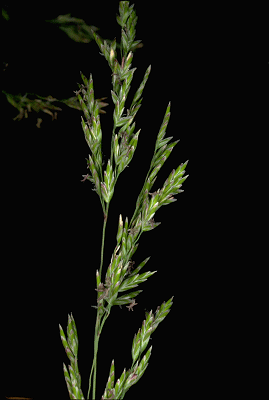Poa labillardierei Steud. Syn.
Pl. Gram. 1:262(1854).
Classification. (GPWG 2001) : Subfamily Pooideae.
Tribe Poeae.
Type of Basionym or
Protologue Information: Australia: N. Holl., Labillardier (HT: ex
herb. Labillandieri); HT: (IT: K).
Key references
(books and floras): [2002] D.Sharp & B.K.Simon, AusGrass, Grasses of
Australia, [2006] J.Jessop, G.R.M.Dashorst, F.M.James, Grasses of South
Australia (152), [2008] S.W.L.Jacobs, R.D.B.Walley & D.J.B.Wheeler, Grasses
of New South Wales (352), [2009] A.Wilson (ed.). Flora of Australia,
Vol 44A. Poaceae 2 (332, 333 as var. labillardierei, 334 as var. acris).
Illustrations:
[1984] N.T.Burbidge. rev. S.W.L.Jacobs, Australian Grasses (221), [2006] J.Jessop, G.R.M.Dashorst,
F.M.James, Grasses of South Australia (152, Fig. 105 & plate 4 as var. labillardieri),
[1984] N.T.Burbidge. rev. S.W.L.Jacobs, Australian Grasses (221), [2008] S.W.L.Jacobs, R.D.B.Whalley
& D.J.B.Wheeler, Grasses of New South Wales, 4th edn (352), [2009].
A.Wilson (ed.), Flora of Australia 44A: Poaceae 2 (332, Fig. 43
333 as var. labillardieri, Fig. 44 as var. labillardieri).
Habit.
Perennial. Culms 30–120 cm tall. Lateral branches simple. Leaves mostly basal.
Leaf-sheaths antrorsely scabrous, glabrous on surface. Ligule a fringed
membrane, a ciliolate membrane, 0.3–0.5 mm long, abaxially hairy, truncate.
Leaf-blades flat or involute, 15–61(–80) cm long, 0.6–5 mm wide. Leaf-blade
surface scabrous, glabrous.
Inflorescence.
Inflorescence compound, a panicle. Panicle lanceolate, 10–26 cm long.
Spikelets.
Spikelets pedicelled. Fertile spikelets many flowered, with at least 2 fertile
florets (3–5), comprising 3–5 fertile floret(s), with diminished florets at the
apex, oblong, laterally compressed, 4–8 mm long.
Glumes. Glumes
similar. Lower glume oblong, membranous, keeled, 1-keeled, 3 -nerved. Upper
glume oblong, 3.2–4.3 mm long, membranous, keeled, 1-keeled, 3 -nerved.
Florets.
Fertile lemma 2.5–4.7 mm long, keeled, 5 -nerved. Lemma surface indumented.
Lodicules present. Anthers 3.
Continental
Distribution: Australasia.
Australian
Distribution: South Australia, Queensland, New South Wales, Victoria,
Tasmania.
South Australia:
Flinders Ranges, Eyre Peninsula, Northern Lofty, Yorke Peninsula, Southern
Lofty, Kangaroo Island, South-eastern. Queensland: Burnett, Darling
Downs, Moreton, South Kennedy, Wide Bay. New South Wales: North Coast,
Central Coast, South Coast, Northern Tablelands, Central Tablelands, Southern
Tablelands, North-Western Slopes, Central-Western Slopes, South-Western Slopes,
South-Western Plains. Victoria: East Gippsland, Eastern Highlands,
Gippsland Highlands, Gippsland Plain, Grampians, Midlands, Otway Plain, Otway
Range, Wilsons Promontory, Riverina, Snowfields, Volcanic Plain, Wannon,
Wimmera. Tasmania: King Island, Furneaux Group, North West, North East,
West Coast, Central Highlands, Midlands, Ben Lomond, East Coast, South West, Mt
Field, Mt Wellington.
Notes. Endemic.
Southern and eastern Australia.
Infra-specific taxa: var. labillardierei, var. acris .
Leaves flat, typically
at least half the length of the culms; sheath usually not pigmented P. labillardieri var. labillardieri
Leaves inrolled, less
than half the length of the culms; sheaths purplish P. labillardieri var.
acris







